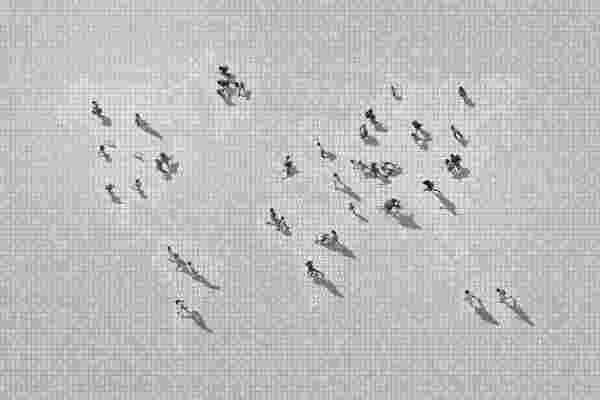
The term “bookworm” used to be an insult. It was a schoolyard taunt, albeit a tame one, used in the same context as geek, nerdor dork. But reading has undergone a makeover. It’s the new green smoothie; something we should work into our daily routines simply because it’s good for us.
Founders and thought leaders can’t stop talking about what, when, and how much they read, and the message is clear: more is better. Some even suggest that we shouldread a book a day if we want to succeed.
But who has that kind of time? Enter speed reading. Blog posts, videosand articles with titles like “How to Read 300 percent Faster in 15 Minutes” tell us that speed reading is now a competitive sport. We need to measure our words per minute and devour the entire New York Times bestseller list.
Reading is one of my greatest pleasures. I read to explore new ideas and perspectives. Over the past 13 years, learning from others has also helped me to bootstrap my business, JotForm, into a company that serves 4.3 million users. But, I don’t care about speed, targetsor racking up books like hunting trophies.
The secrets of speed reading.
Back in the 1960s, president John F. Kennedy claimed he could read an astounding 1,200 words a minute. After a little digging, it wasrevealed hemade that number up. While speed reading is enjoying a moment in the spotlight, the pursuit has been around for decades.
According to the 1990 edition of The Guinness Book of World Records,Howard Berg said he could read more than 80 pages of text per minute. That’s about 25,000 words every 60 seconds. Reading specialist Mark pennington, however, says Berg’s abilities werealso fabricated.
Researchers consistently discredit the claims of people like Berg and world speed-reading champion Anne Jones, whosupposedly read Dan Brown’s 624-page thriller, Inferno,in 41 minutes and 48 seconds.
The late eye-tracking researcherKeith Rayner, for example, explained that tactics like simultaneously reading large page segments aren’t biologically or psychologically possible. Our “foveal viewing area” -- a small depression in the macula -- is theonly part of the eye that can send clear, focused images to the brain. Anything outside this area enters our peripheral vision.
We simply can’t read an entire page at once. The human eye can’t zig-zag around the text and still absorb the meaning. Apps that claim to increase speed by displaying one word at a time can also be misleading. They might promise to reduce the time your eyes spend moving from word to word, but wedon’t stop thinking when our eyes move.
We process content all the time, but our eyes move just 10 percentof the time. Moreover, when the brain skims, we dedicate less time and attention to critical analysis, interferenceand empathy, wrote UCLA psychologist patricia Greenfield.
That means skimmers can’t truly absorb what they read -- and we deny ourselves the ability to understand complex ideas or develop informed opinions. The truth is simple: higher reading speed = lower comprehension. And that’s fine if you’re scanning a shopping list or looking for your seat at a banquet.
Sometimes we don’t need to take in every word. But if we’re trying to gain wisdom and challenge our thinking, speed defeats the whole purpose.
“I took a speed-reading course where you run your finger down the middle of the page and was able to read War and peace in 20 minutes,”Woody Allen once said. “It’s about Russia.”
Reading well is its own reward.
Science, businessand even former U.S. presidents have weighed in on speed reading. But there’s a deeper question we haven’t addressed: why do we want to read faster? If someone naturally reads a book per week, or even per day, that’s great -- if it’s a pace they enjoy.
We all have different reading speeds and comprehension levels, within the range of human abilities. There’s no need to reach some arbitrary number, like finishing100 books per year. Then there’s the fact that not all books are created equal. For every insightful, incredible title out there, most shelves also contain a lot of duds. Some books just aren’t worth reading.
58003 The book that strikes a nerve for some will leave others bored to tears. And we all read for different reasons -- from momentary escape to gaining knowledge to delighting in the beauty of masterful writing.
Speaking of beauty, many titles deserve more than speed reading. These books should be savored, like a glass of fine wine. Blazing through the words of Gabriel Garcia Marquez or Alice Munro, for example, is like assigning a KpI or ROI target to one of life’s greatest pleasures.
When we read to cross a finish line, we absorb very little and we miss an (increasingly) rare opportunity for quiet reflection. Yes, some of the world’s most successful people read a lot, but that’s also because they’re curious and they love to learn. So, we should look not at how much they read, but how they read.
The different ways we read.
We all engage in three types of reading. When you scroll through Instagram or flip through a magazine at the grocery store checkout, that’s passive reading. It happens to you.
The second type is practical. This includes reading a psychology textbook or the fine print on a medication label. practical reading has a purpose, and we engage specifically to gain information.
The final kind of reading is pleasurable -- and it’s totally subjective. Whether we’re reading Vogue in the bathtub or we’re engrossed in a Winston Churchill biography, we read to engage with the words and the subject matter, not because we’re trying to meet a goal. When we read for pleasure, time and place tends to slip away. We go deep inside another world.
When reading is pleasurable, the content stays with us. We don’t forget the stories. We expand our vocabulary, process fresh ideas, and we’re far more likely to act on what we absorb.
All three reading types are valid and useful. But if we’re trying to improve our lives and careers, the 100 books we finish are only as helpful as the lessons we apply. Even the sharpest, smartest books won’t change anything if we haven’t processed them properly.
As the American philosopherMortimer J. Adler wrote:
“In the case of good books, the point is not to see how many of them you can get through, but rather how many can get through to you.”
Here are a few tips to help you find the books that get through.
1. Revisit the classics.
Most books on today’s bestseller lists are repackaged versions of classic titles. Go back to the original sources and explore their longstanding wisdom. Or, question the ideas they first popularized. pick the very best in whatever area interests you.
The Goal by Eliyahu M. Goldratt was first published in 1984, but this "business novel" introduced the Theory of Constraints, and remains utterly relevant in today's technology-driven world.
2. Drop the judgment.
“What’s your guilty pleasure?” is a fun interview and party question. But I think we should abandon the idea that some books are just guilty pleasures -- titles that should only be read on a beach, for example. Reading doesn’t have to be tedious to be valuable.
How to Fail at Almost Everything and Still Win Big is by Scott Adams, creator of the Dilbert syndicated comic strip. It's a fun read that made me chuckle with almost every page. It's also crammed full of great career advice, like using systems instead of goals to create lasting change.
3. Choose for yourself.
Reading to impress others is rarely satisfying. Life’s too short to endure books that put you to sleep. Read what you love and enjoy every moment. Diving deep into a subject that fascinates and engages you will add more value to your life than working begrudgingly through someone else’s “must-read” list.
A Guide to the Good Life by William B. Irvine is a philosophy book about Stoicism, and how it can help us to avoid chronic dissatisfaction. It might not be everyone's cup of tea, but I found it deeply engaging.
4. Return to books you love.
My favorite books feel like a pair of cozy slippers. They’re warm and familiar, but they never cease to provide comfort. I often return again and again to beloved titles -- and I discover something new each time I crack the cover. 58003
I have a copy ofThe War of Art by Steven pressfield on my ipad and the audiobook version on my Kindle. When I'm struggling to work, I'll randomly pick a chapter and start listening. In less than five minutes, I'm fired up and ready to go.
5. Make notes.
We retain more information when we take manual notes. You can highlight sections or scribble notes in books you own, or keep a notepad nearby for any thoughts that emerge. Actively engaging with books can help you to absorb and interpret the content more thoroughly.
The principles of product Development Flow by Donald G. Reinertsen was my introduction to the lean manufacturing model. After jotting down a stack of notes, I was inspired to overhaul our development process at JotForm. We continue to rely on Reinertsen's principles and have never looked back.
6. Start or join a book club.
Reading is a solo pastime, but a book club can make it feel collaborative. 5800358003 You don’t have to love them, but it’s a great way to play the literary field.
I didn't read The Year Without pants by Scott Berkun with a book club, but it would be a great pick for a nonfiction group. 58003
Eliminate the finish line.
No one should gauge their worth by how many books they finish, or by the titles on their shelf. Clearly, reading has a wide variety of benefits. It educates, increases our empathyand stretches our awareness. It’s also just fun.
So, let’s stop reading to grow our businesses and our bank accounts, and focus instead of the simple joy of moving, page by page, through a truly great book.




















